In 1999, a book called The Places Rated Almanac offered a ranking of American cities in terms of their desirability as places to live. There are a lot of these rankings – they’re now a staple of click-based internet culture. There’s nothing preventing you from creating your own arbitrary ranking of America’s best or worst cities. Indeed, you could misread the project that I’m trying to do here, visiting what I’m calling “undervalued cities”, as a ranking of the potentially worst. (My point, in case that hasn’t been clear, is that these places are often surprisingly great and that market prices don’t always equal lived reality.)
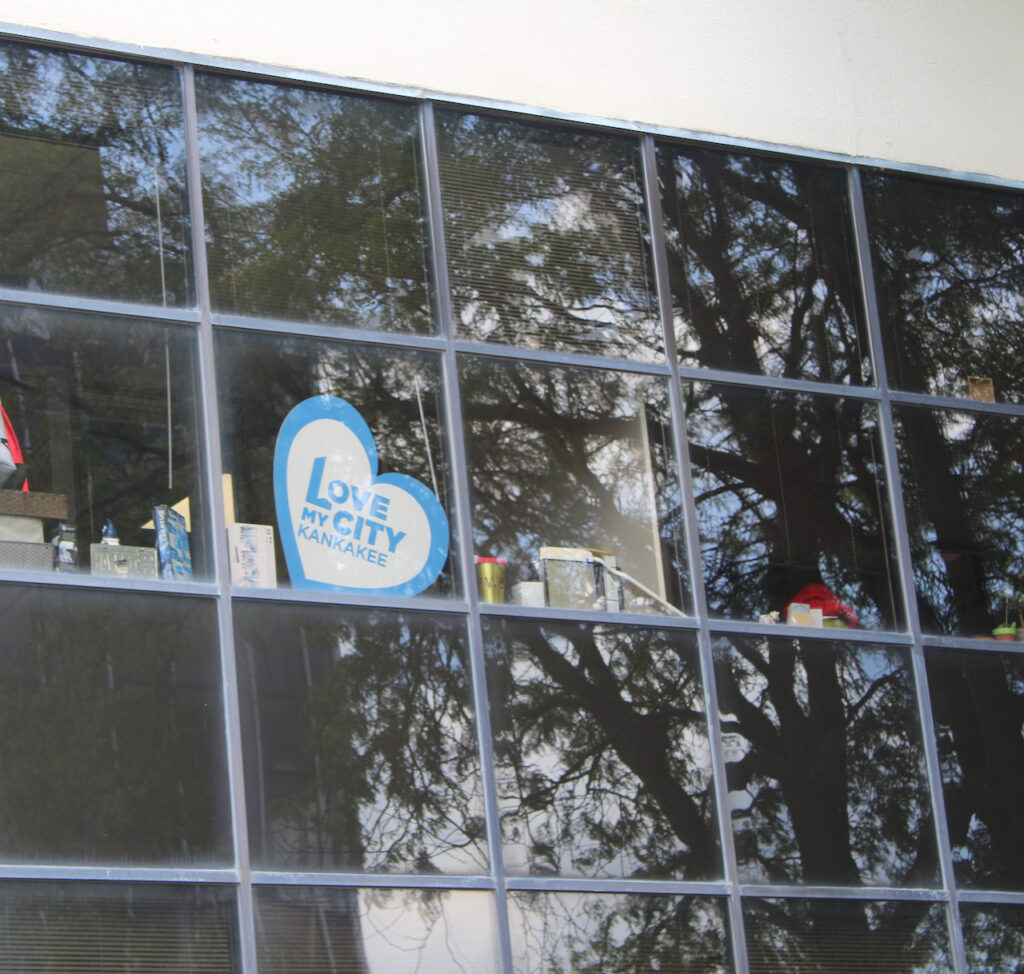
This particular listing offered Kankakee, Illinois as the worst city in the United States in terms of crime, job prospects, and other quality of life factors. Being ranked last on someone’s arbitrary list wouldn’t have been a big deal but for the fact that David Letterman, at that point an enormously popular late night host, made Kankakee a regular bit. First, he did his top ten list on Kankakee, offering possible tourism slogans:
Number ten. You’ll come for a pay phone. You’ll stay because your car’s been stolen. Number nine. Ask about our staggering unemployment rate. Number eight. We put the ill in Illinois. Number seven. We also put the annoy in Illinois.
Then, in a subsequent week, he called the mayor to ask whether the attention to the town had caused any problems. The mayor, Donald Green, turned out to be a funny guy. Asked what the Indian name “Kankakee” meant, he quipped, “middle-class factory town”. To keep the gag going and to “help” Kankakee, Letterman gifted the town with a gazebo… and then a few weeks later, with another gazebo so that Kankakee could attract tourists to the twin gazebos of Kankakee.
The charming part of the story happens fifteen years later, when students researching their hometown in 2014 found their town as the butt of a joke on national television. They’re all familiar with these gazebos, but now they see them in a very different light. They see them as tangible evidence of something that they feel every day living in Kankakee, which is the ways in which they are look down on and made fun of by residents in neighboring towns. Kankakee is what you might call the “anchor city” – while it’s a small town (24,000), it’s the biggest population center and the county seat for a relatively rural region of northern Illinois. (My trip is ordered around MSAs – metropolitan statistical areas – and this leads to some weird disparities. Gary Indiana with 68,000 people is part of the Chicago MSA, while Kankakee stands on its own.)
Driving through Kankakee, it’s at the junction between the parts of Illinois that are soy and corn, and the part that’s America’s steel belt. When some of the industrial employers in Kankakee shut down, as has happened all over the Great Lakes region, there was an exodus from the town, particularly white flight to neighboring suburbs. The city is now 38% black, 34% white and 23% latino which has led some in the surrounding suburbs to refer to the city as “ghetto”. This American Life, which did an excellent piece on Kankakee and the fate of the gazebos, reports that “skankakee” has an entry in Urban Dictionary – I couldn’t find it.
Still, it’s This American Life from which I head the story of students mobilizing to tear down the gazebos. Correctly assuming they’ll be accused of tearing things down rather than building them up, they decide to build something positive: a rocking chair to celebrate Dave Letterman’s retirement, presented to him in a ceremony in a downtown movie theater that Letterman sends camera crews to broadcast.
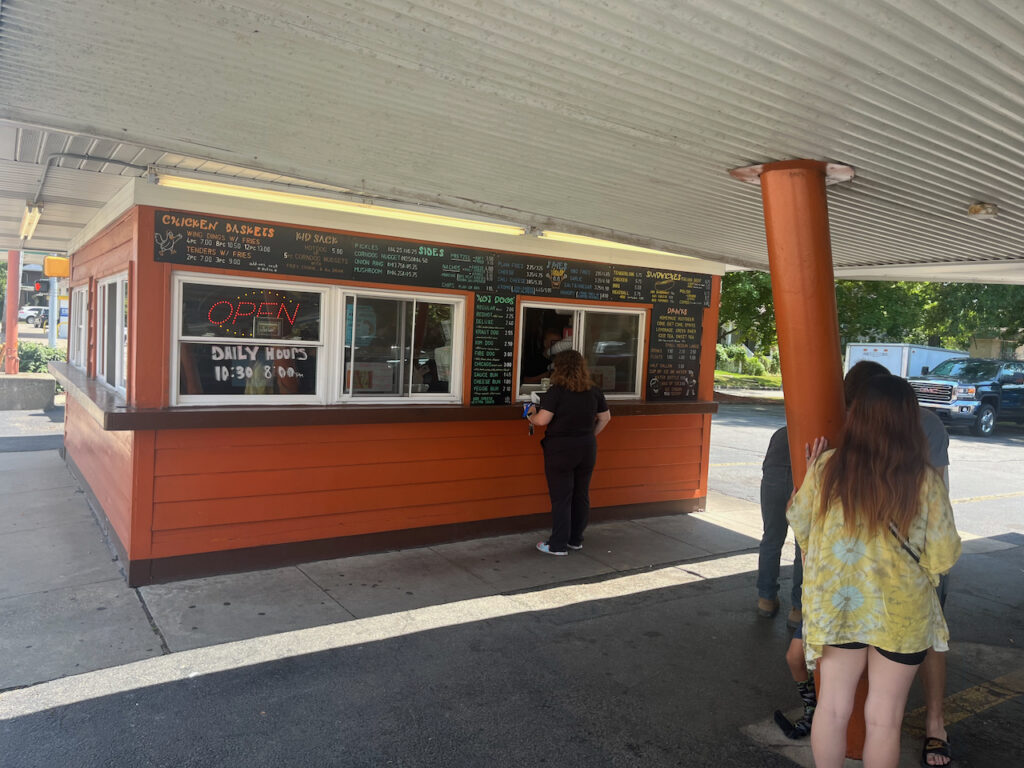
Jaenicke’s Root Beer stand, Kankakee
I found the TAL story while waiting for my Italian beef at Jaenicke’s Root Beer Stand, looking for background on the city. All I knew before arriving was its mention in the folk song “The City of New Orleans” about the legendary train that ran down the Mississippi. As such, I started my tour of the city visiting the Kankakee Railroad Museum, which is run primarily by model railroad enthusiasts who built wonderful HO, O and N scale rail layouts, representing not only Kankakee in its glory days, but some of the other great cities of the area.
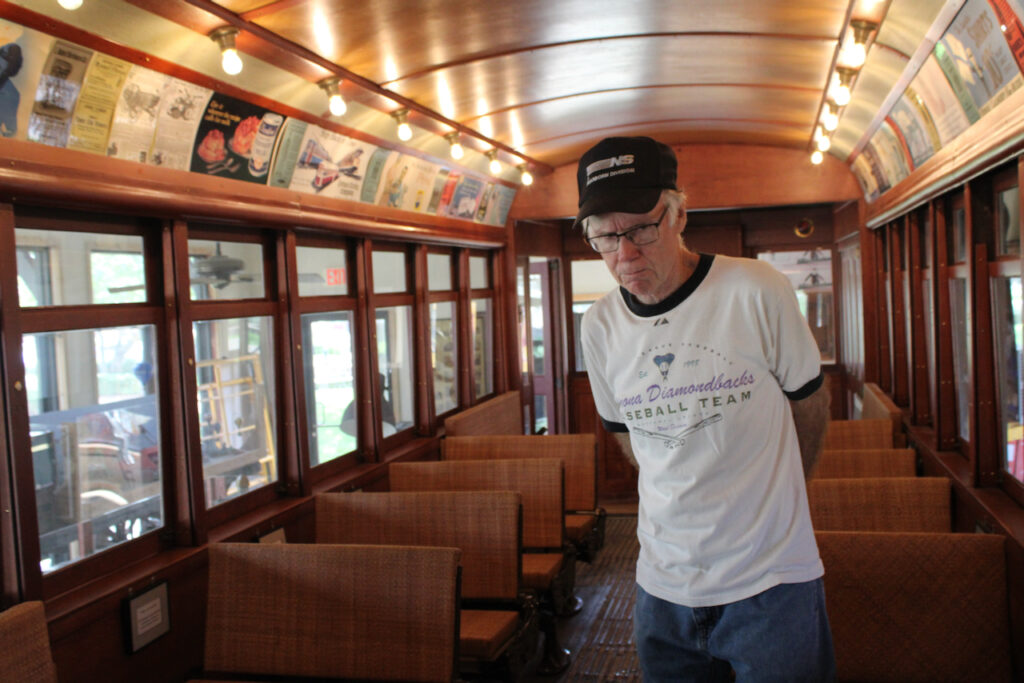
A car from the North Kankakee city electric trolley.
My tour guide had worked with the Illinois Central Rail and walked us through a caboose showing what railmen used to do, watching the train go around the corner to see if anything was dragging or sparking, something that might indicate a stuck brake or any other potential dangerous situation. According to my guide, the Kankakee River was the first major barrier to the railroad coming south out of Chicago, so the city gained a roundhouse, a mechanical device that allows trains to around on a giant rotating platter, so that the train had gone from Chicago to Kankakee could go back. Once steel bridges made it possible to cross the river, Kankakee emerged as a railroad hub with four major lines coming through the city. As I’m finding all across my travels, having transit turns out to be the key towards having industry. If you have access to rail, you’ve got access to raw materials and a path to ship out your finished goods. And so Kankakee, in the 19th and much of the 20th century became a middle class factory town.
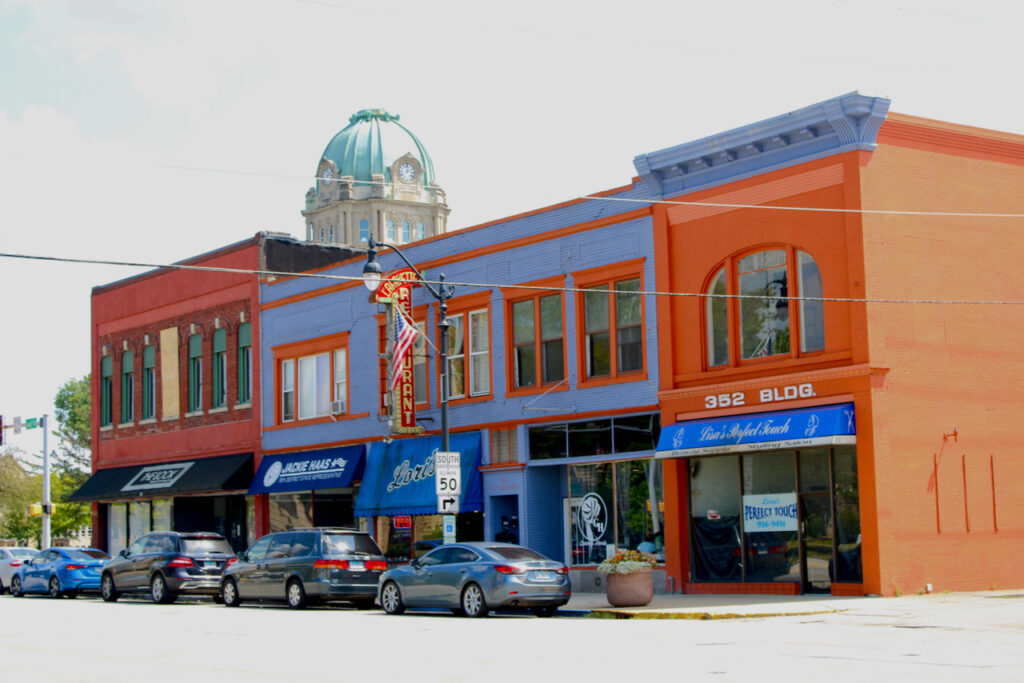
Commercial Kankakee
While Kankakee is certainly not the most vital looking city I’ve seen on my trip, it’s not the worst either. And it’s got the feeling of a town that has something to celebrate in terms of its diversity. One of the prettier blocks in town features two beauty shops, one featuring hair braiding, presumably for a black clientele, while the other advertises mostly in Spanish, presumably for a Latina audience. They bracket a cafe that seems to be popular with Kankakeeans of all backgrounds. Across town is a wealth of taquerias, mercados and carnecerias, pointing to a Chicano population and there’s some colorful aspects of hiphop culture, some tricked out SUVs and one very joyful young black man driving around on a garishly painted Slingshot, an open-roofed motorcycle trike. I can imagine this feeling unfamiliar to someone visiting from a small agricultural town or suburb. But it felt to me like a vital place, working to turn itself around. And mostly, it felt like a place saddled with an unfair reputation.
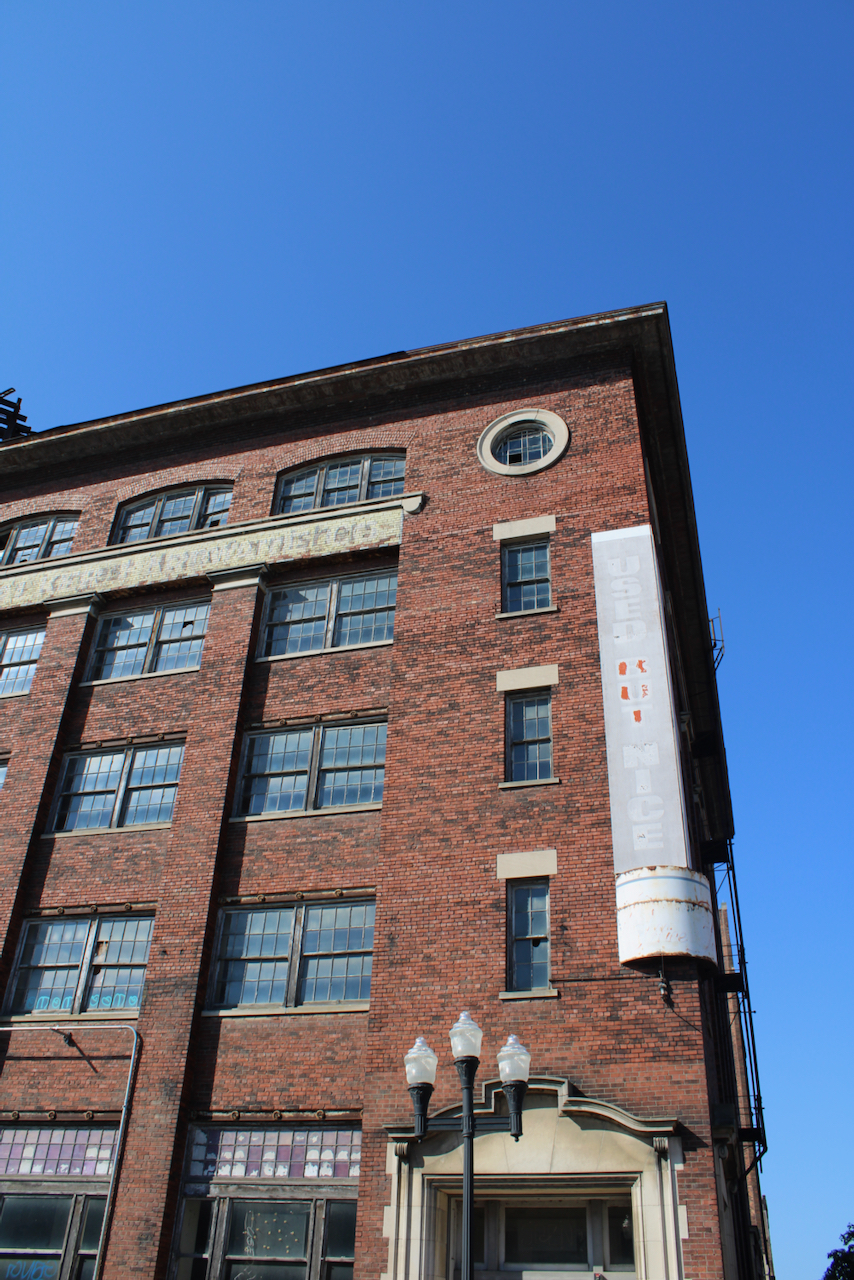
I woke up that day in Peoria, a city I knew only from a set of vaudeville-era references. I’d always understood the expression “Will it play in Peoria?” to refer to a town that was backwards, hopelessly middle-American and unwilling to experiment. Turns out that’s entirely wrong. Instead, Peoria was a popular stop on the vaudeville circuit, closely linked to Chicago on rail, and was often used as a place to try out new material because the audience was experienced and critical. Whether or not something played in Peoria would often dictate how well it would do out on the road.
The phrase took on another meeting when people started using Peoria as a test market, because it had demographics similar to the country as a whole. Then the question of “Will it play in Peoria” became a proxy for “Would a people buy it coming from the city that had roughly the same representation as the nation as a whole?” That changed years ago, Tulsa became the city as Peoria became less white, more black, and less close to representing the nation as a whole.
Peoria has always been the but of certain jokes. Some theorize that, like Kankakee, it’s a fun name to say. Peoria has this wonderful set of mellifluous vowels, which may make it a particularly good punchline, as in, “I spent the four longest years with my life in Peoria one night last week.”
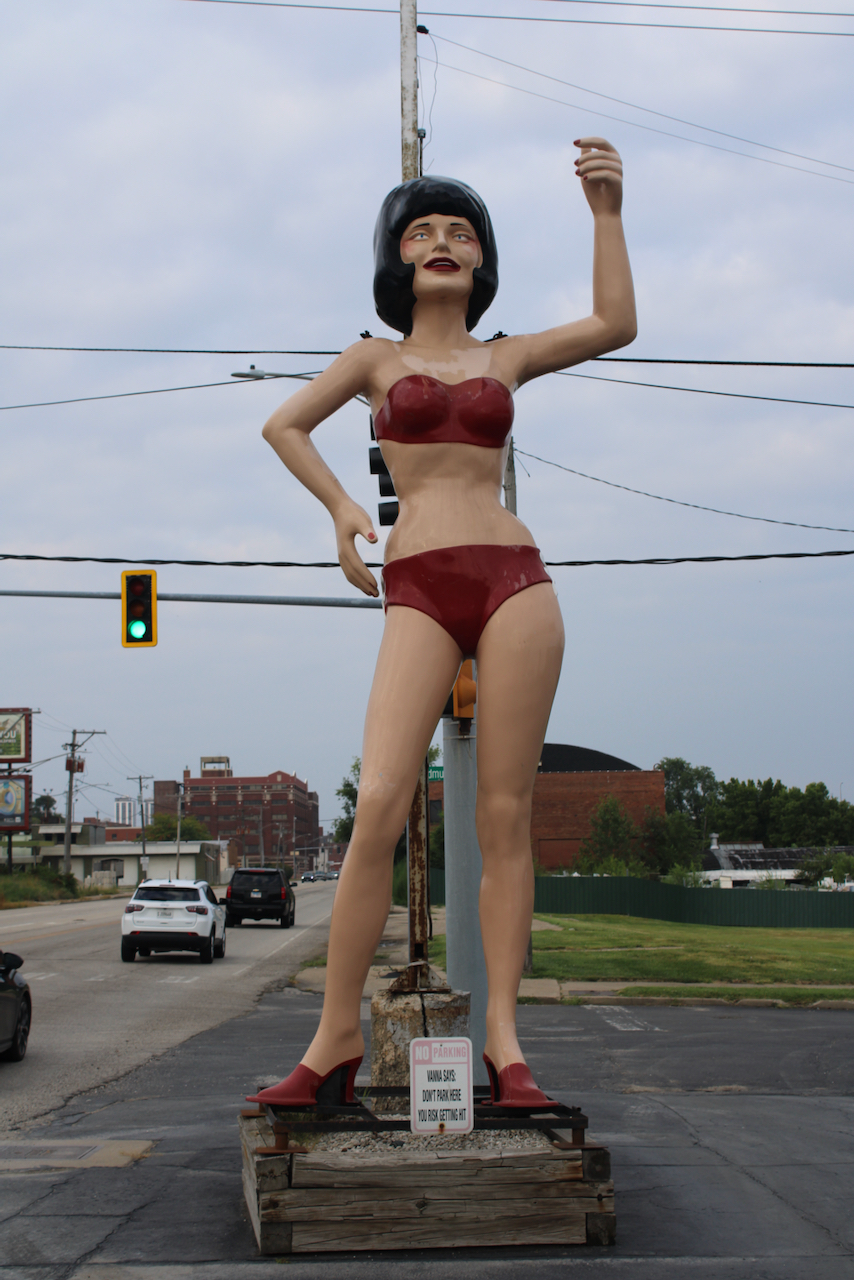
The sign for a local auto shop. Evidently she’s clothed in the winter but emerges when it’s beach season. Peoria, IL
I like Peoria a lot – it’s high on my list of favorite towns on this trip so far. It’s beautifully situated on the Illinois River, and the town is figuring out how to reclaim that space that traditionally has belonged to factories and turn it into a centerpiece of the town. I ran that morning on a trail that follows the river from a riverfront park across the street from Caterpillar’s Visitor Center and a glossy new riverfront museum. Caterpillar’s no longer headquartered in Peoria, but they still have a major presence and some large factories. The Catepillar visitor’s center is a major tourist attraction, with simulators that let you experience driving Catepillar’s big machines. I didn’t visit because I would have felt bad elbowing small children out of my way for a turn.
Peoria’s Riverfront Museum is a great attempt to create a big city museum experience for a comparatively small community (111,000). It’s got a planetarium, a big screen not-quite-IMAX theater, and a set of exhibits that feature some excellent contemporary art and a wonderful overview of local history. The city is the birthplace of Richard Pryor, who began his stand-up career in Peoria’s clubs before conquering the nation. There’s an exhibit on Poro Beauty, whose founder became the country’s first black female millionaire. Peoria is the home of the first commercial automobile made in the United States, which inspired Henry Ford.
Peoria has a lot to be proud of, and the city seems to be putting its best foot forward. There’s a sculpture walk, a mural welcoming people to the community, and an active group of downtown businesses working to encourage people to discover the city. There are some exciting restaurants, a climbing gym, as well as lots of the other features you’d expect in a downtown looking to attract people to loft living in some of the old buildings. Peoria’s got one of the problems I see in many towns as they look for their next act, which is that it’s almost always easier to build new than it is to get people to reconsider the downtown. East Peoria is a pleasant, but boring array of your standard American big box stores and restaurants just over the bridge from the historic center.
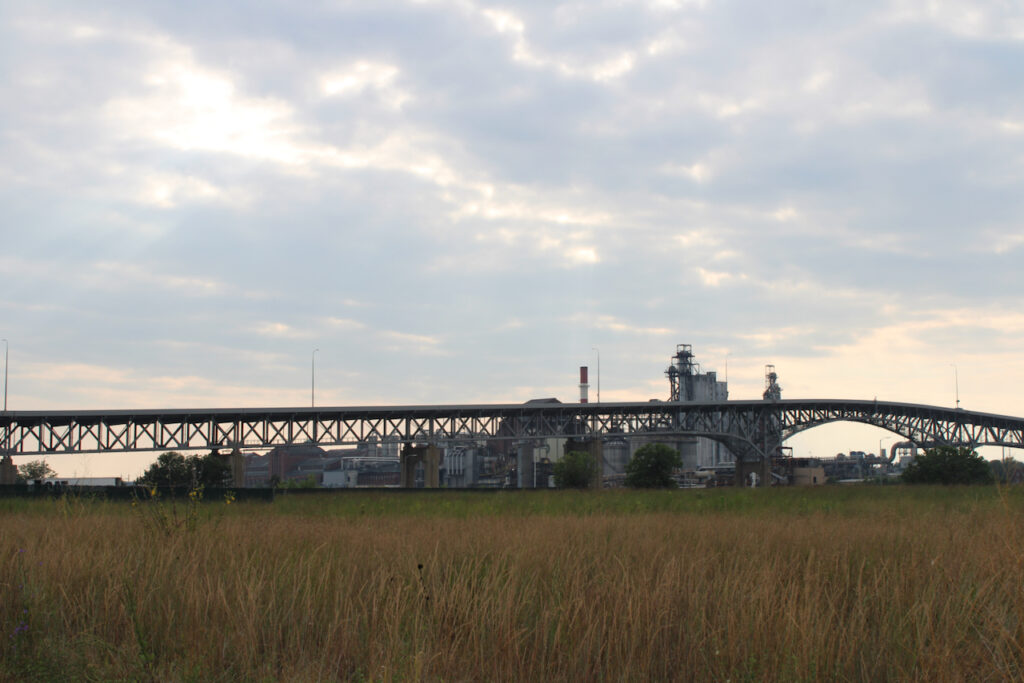
Across the Illinois River to the former Hiram Walker distillery in Peoria, IL
As I explored deeper into the city, I started finding Black and Mexican Peoria, including a wonderful spot for catfish and okra in the back of a local market. I also get the sense that, despite my misconceptions of Peoria as straight laced and boring, that it’s a good place to have fun. Looking for the old Hiram Walker distillery, which now makes commercial ethanol for fuel, I stumbled onto two strip clubs that seem to be doing a brisk business. As I was checking in at a downtown hotel, guests were preparing themselves for a night out in a city that has a history of bootlegging, mobsters and having always been a good place to have a good time.
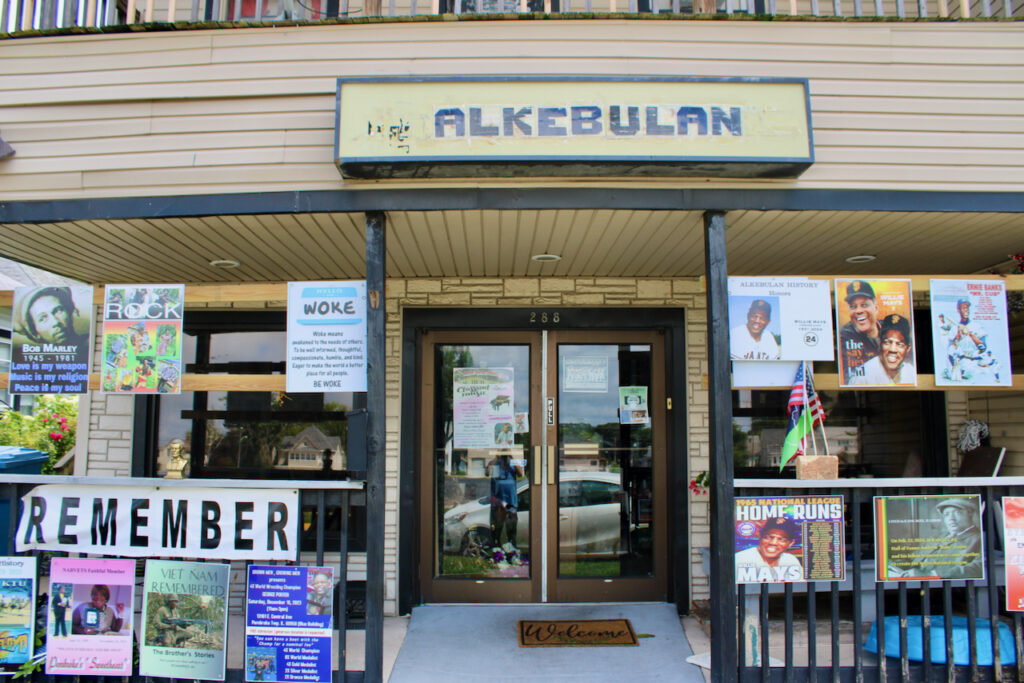
The Alkebulan Museum in Kankakee
Peoria’s got investment from Caterpillar and other local employers and absolutely feels like a town on the rise. It’s harder to know where Kankakee is going. On my way into town, I stumbled onto a museum that didn’t appear on any of my maps. It was closed, but the signage made clear that someone is working hard to preserve Kankakee’s Black history and culture. At the end of the day, that’s what really matters: whether or not someone loves a city and is working hard to take care of it. I look forward to visiting the Alkebulan the next time through town. And perhaps I’ll figure out how to party in Peoria in my middle aged sober sort of way.
The trip so far:
Driving by Data Set
By the numbers: What statistics can and can’t tell you about undervalued cities
A Square Deal in Binghamton
Buried, with dignity, in Elmira
Side Quest in northern Ohio
In search of the “statistically improbable restaurant”
Decatur – From corn to soy to crickets?
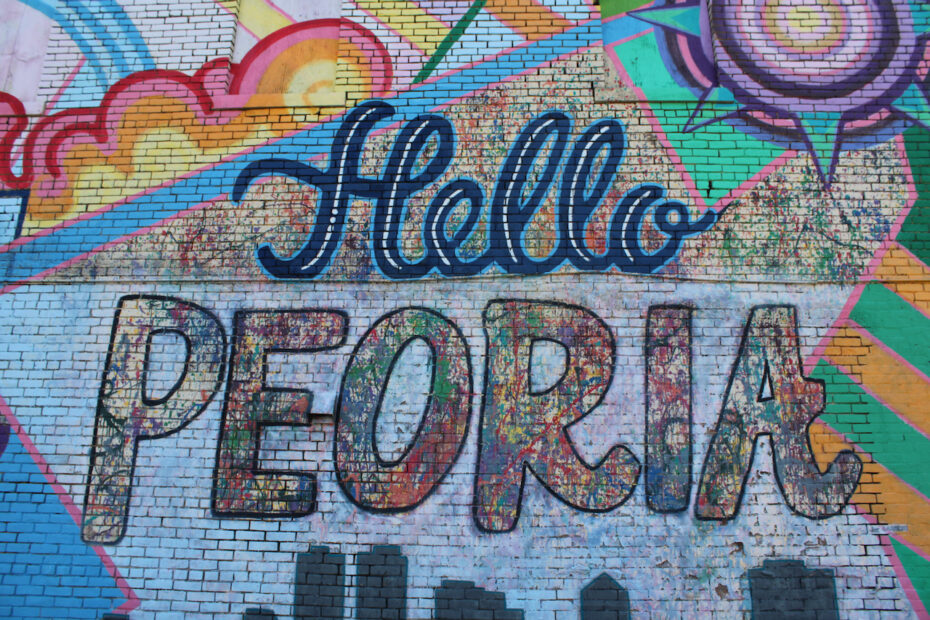
I am loving these posts. Thank you for letting me tag along from my armchair.
The giant equipment in the Caterpillar museum is SO fun, can confirm. I used to be an archivist for McDonald’s in Chicago and we once took a field trip to Peoria to visit our buddies who ran the Caterpillar archives. It was a very impressive center.
This is great. Thank you for the posts! I’m interested in the outsize cultural impact of some of these towns. Several of them have a national profile, despite having tiny populations. To explore this, somebody (you?) should develop an index of “cultural resonance” (e.g. Letterman mentions, appearances in songs and books, settings for TV shows, etc.) per resident – call it “cultres” or something. Sure, LA and New York would have enormous resonance, but their equally enormous populations would bring the index way down. Peoria (where, for example, a surprising number of movies have been filmed: https://www.pjstar.com/story/entertainment/movies/2022/02/28/marry-me-latest-movie-set-filmed-peoria-illinois/6882930001/) would probably end up with a really high cultres score. It would be interesting to see which towns wind up on top of national lists of that index.
Pingback: Road trip: The Company Town and the Corn Fields - Ethan Zuckerman
This reminds me of the old saying, we bombed in New Haven. That was the big tryout town for NYC theater. This was a point in the movie The Band Wagon. It sounds like Peoria played a similar role but for Chicago.